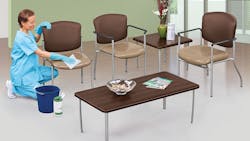The COVID-19 pandemic has forced major changes in the way people work, live, and access health care. Dental offices are especially affected, as caregivers need to be in close proximity to unmasked patients, which puts them at risk for droplet transmission. The Centers for Disease Control and Prevention has published specific guidelines for dental providers to effectively navigate the COVID crisis, and this information is updated regularly as the situation evolves. It can be accessed at cdc.gov/coronavirus/2019-ncov/hcp/dental-settings.html.
Since dental providers have reopened, their concern is how to deliver quality care in a way that keeps both patients and caregivers safe. Following CDC protocols regarding proper personal protective equipment (PPE) and cleaning between patients are critical, but modifying the office design can help in the fight against COVID as well.
Reimagine your waiting room
The traditional waiting room had rows of chairs and stacks of magazines that were used by many people. As practices now schedule patient flow to make sure there is limited contact with others, there should be much lower density in waiting areas and common spaces. Now is the time to remove extra furniture and ensure that there are safe distances between open seats. Make sure that hand hygiene supplies are easily accessible to visitors and that masks are provided when necessary.
Technology can help make the waiting area a more enjoyable and sanitary space, and it can have long-term benefits for your practice. Offering Wi-Fi gives patients the chance to work, decompress, and be entertained while they wait. Consider offering self check-in kiosks or digital check-in. This eliminates a point of infection and saves the staff time.
Reevaluate materials
Consistent and thorough cleaning is critical to infection control, and this also applies to furniture and fixtures. Using harsh disinfectants can take a toll on materials such as wood and fabric, causing them to quickly degrade and fail. When cleaning, follow the manufacturer’s instructions (pay attention to the dwell time needed to eliminate bacteria and viruses) and be sure to rinse with clean water to remove chemical residue to help prolong the material’s life.
Standard upholstery and wood can add a warm, welcome look to your space, but both are porous and cannot be effectively disinfected. Fabric in particular can trap and hold bacteria deep within fibers, making the material a real challenge to clean. It’s worth considering replacing wood or fabric items with more durable and cleanable options made from vinyl and metal. These materials can be easily cleaned and have a high resistance to chemical disinfectants, which will ensure a long and useful life.
Maintain separation
Many dental practices have moved to open or semiopen bay designs versus closed exam rooms. This allows for a better workflow, and patients feel more relaxed. In a COVID world, open spaces with potential droplet spray can be an infection control hazard.
In addition to rigorous cleaning procedures, temporary or semipermanent space division should be considered. This can be as simple as freestanding or mobile dividers that are tall and wide enough to block particles. However, they should not interfere with sprinkler systems or air handling vents. If you use a temporary solution, be sure that the product is made of durable, cleanable, nonporous material that can take repeated cleanings with harsh chemicals. An additional benefit to portable dividers is that they can be moved, reused, and eventually removed when no longer needed. A more permanent solution could be building “pony” or partial-height walls between procedure areas. This involves hiring a contractor and ensures that critical building systems are not disrupted, and it provides a permanent solution that requires little long-term maintenance.
Communication is key
Your practice has likely implemented many changes in order to safely reopen during the pandemic. Communication with staff and patients is key to make sure these changes are effective. Be sure to screen patients ahead of their appointments so you can know about any potential symptoms. Mandatory mask and visitor policies should be explained thoroughly before appointments so that patients know exactly what to expect. Communicate all of the steps that your office is taking to ensure safety. This might mean explaining new cleaning protocols or reviewing the enhanced PPE. Staff should fully understand any new policies and be prepared to answer patient questions.
Oral health is an important part of overall health. Reopening your dental practice safely is critical to your patients and community. Following updated CDC guidelines is the first step to ensuring a safe restart. Considering easy-to-implement design changes can also help in your efforts to be safe.
JOANNA TERRY is the director of health-care sales at National Business Furniture. Visit nationalbusinessfurniture.com.
About the Author
Joanna Terry
JOANNA TERRY is the director of health-care sales at National Business Furniture. Visit nationalbusinessfurniture.com.
